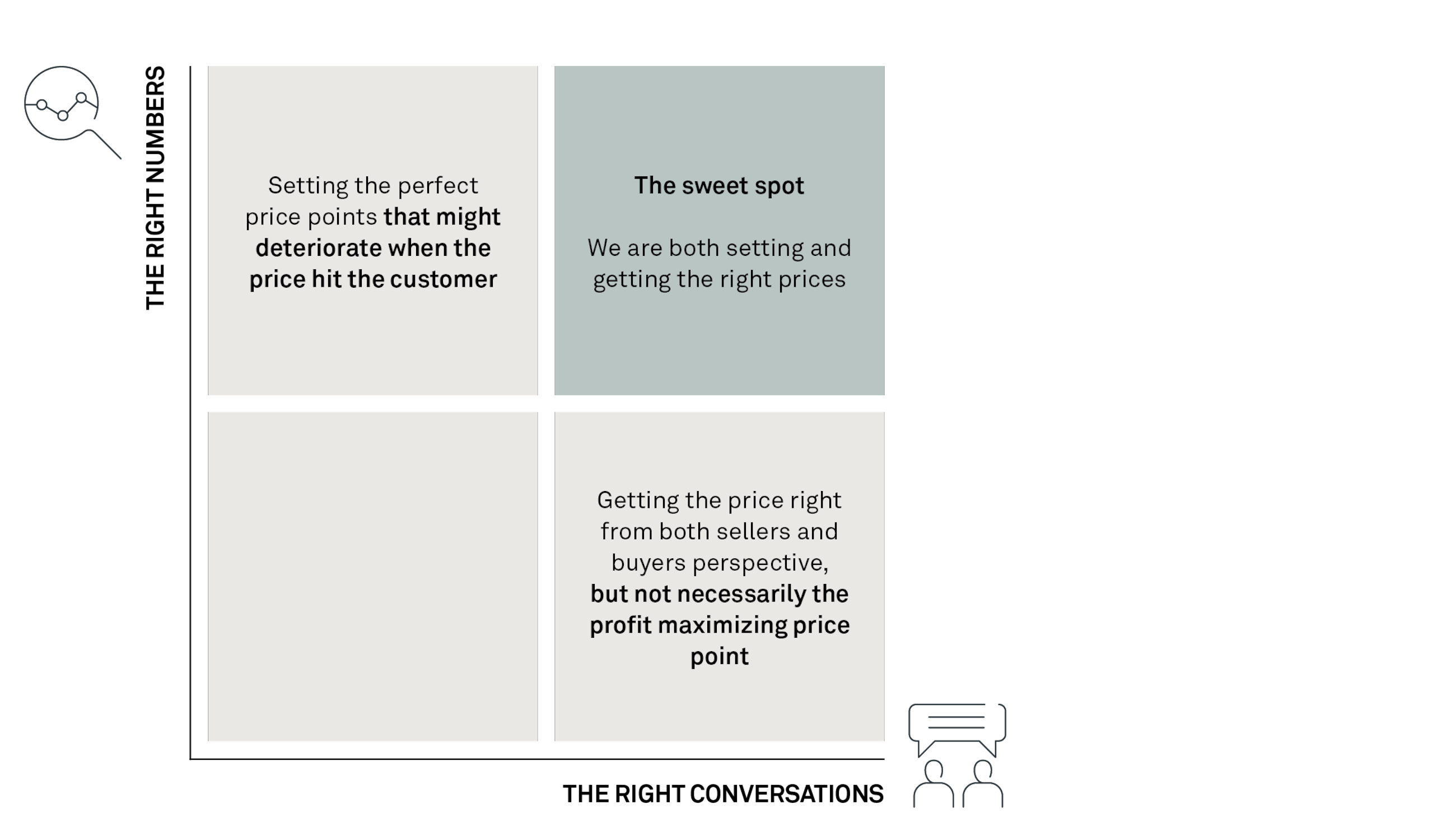Why data alone will not help us boost profits
19 September 2018
There is no doubt that data and analytics are every bit as vital to pricing as music is to a good party. However, I think all of us have been to parties where – no matter how good the music – people just did not start dancing. We argue that pricing – exactly as an invitation to dance – is about the right data and the right conversations.
The ability to analyse numbers is one of our most substantial tools in price management, and it is not our intent to challenge that. However, we want to raise the question: How can we turn our insights from data into effective action and achieve sustainable behavioural change? How can we make the commercial players in our organisation behave in the “pricers’ best interest”?
Face the ugly truth: Most people don’t get very excited by numbers
I have a good friend named Alex who, like me, is very much into numbers and very much into football. In fact, he is a passionate professional football coach. Alex recently learnt about a rather new discipline called people analytics and how professional sports teams are using this data-driven approach to improve their performance.
Excited by the idea of combining both of his passions, he went to conferences, read loads of books and learnt what there was to learn about analysing player data. He started collecting data and built a player database. Slicing and dicing the data, he was able to identify several things that he was convinced could be improved and would have a positive impact on the team’s success. Energised by his findings, he went back, showed his analysis in detail to the team and told them which capabilities they needed to work on to become more successful. How do you think the team reacted?
Not only didn’t they understand what he was saying. They started questioning his abilities to coach a football team. In fact, he was threatened by the club management to lose his position. But Alex was confident that his insights would benefit the team, and luckily, he was stubborn enough to give it another try; only this time by pursuing a different approach. When he changed the conversations that he had with his players, the situation began to improve. As an example, he started to talk to the strikers about the importance for them to score more goals and how becoming faster on the first 10 metres could help them to succeed with that. If you are wondering what this has to do with pricing, you should read on.
If we keep nurturing our role as “number nerds”, we will not succeed in engaging the commercial organisation
Many business leaders find themselves in a similar situation as Alex. Research shows that only 33% of all change projects deliver the impact intended, and the main reason for that is employee resistance to change. From our many years of experience with commercial transformation projects, we know that this is particularly true for pricing initiatives.
As pricing professionals, we are often very analytically driven characters, and we tend to forget that we are quite different from most of our commercial colleagues. If we in pricing are the football coaches, then the team on the pitch is most probably the sales organisation. Clearly, we share the objectives of value capturing, selling and boosting revenue and profit with the rest of the commercial organisation. However, the way we think – and therefore the way we talk about value creation and profits – is substantially different. As a result, we end up speaking completely different languages. A pricing director of a global industrial company and one of our clients recently concluded: “… we are in a war with sales – they just hate us”.
This being an extreme case it is yet another good example to illustrate the tensions and conflicts we find in most commercial organisations we engage with. In our experience, most of these conflicts are rooted in little more than misunderstandings based on different ways of talking about the same objectives. Commercial organisations can release a huge untapped potential by resolving these conflicts.
Just as the striker in Alex’s football team, our sales people don’t care about our fancy analytics and pricing KPIs to improve. And yet they are the ones to act in our interest when “the ball hits the grass” or in this case “the price hits the customer”. We can only translate our insights and tailor our message towards them if we understand what drives the behaviour of the different roles in our commercial organisation.
Conversations are the key to convey our message – so we need to design them for our purpose
Thinking about how we can spread our new and perfectly tailored message to infuse a new way of thinking around pricing in our organisation, we come to face the next challenge: How can we reach our target audience? Send out a slide deck? Set up a training programme?
Having successfully implemented many pricing initiatives, we believe in the power of conversations between commercial leaders and front-line people. Therefore, we are convinced that we can drive new behaviours in the commercial front line through more focused, frequent and ambitious leadership interactions. Knowing that these conversations will not happen by accident, we need to design them for our purpose. “Designing a conversation?”, you might ask, “what does that mean?”
By designing a conversation, we mean to consciously select what topics to discuss and what tools to use for facilitation to create energy and commitment. It seems obvious that we must define clear objectives that are aligned with the behavioural change we want to foster – and yet it is too often forgotten. If we use real-life examples from the front line to enforce the “why” of your counterpart, it helps them to make the connection to their personal pains and gains.
Few but carefully selected supporting tools can have an enormous impact on how effective the conversation is going to be. One ingredient is the right setup of the room and tailored visual boards that are designed for the target group and help to facilitate the conversation by showing both the things to be done and the impact achieved.
Finally, we need to keep the ball rolling. Change is not a one-time thing. It must be nurtured and sustained. Hence, we need to define a fixed cadence for the interactions and follow up on the agreed to-dos to achieve progress.
We constantly need to remind ourselves of one thing, when we put all the components of a great commercial conversation around pricing together: Keep it simple! Avoid falling back into patterns of our analytical mind. Make sure to install a sanity check for this before taking off.
Just like Alex, we need to get the people hooked on what is important for them. Being able to communicate how we can help them to reach their goals is the ultimate key to successfully implementing commercial change initiatives. As pricing is a discipline that is often misunderstood, we are convinced that it is even more important and essential for success in this field. When we help clients with their pricing, we leverage the latest advances in data science to find the right numbers, but first and foremost, we install the right conversations.
How to organise your pricing function
Are you about to reorganise the way that your organisation makes pricing decisions? If so, this article will help you navigate the multitude of options.
Read more



